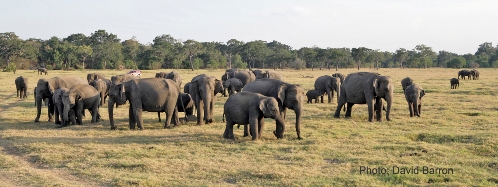Rains flood grassland: elephants move
30 November 2011. The monsoon rains have flooded the grasslands encircling dry-zone tanks. Deprived of their favorite feeding grounds, elephants move to higher ground.
Elephants swim our lake and visit our neighbor’s garden for better feeding opportunities.
For the past week, and elephant cow and her youngster (about 5 yr old) have come to our next door neighbor’s garden (100 m south of us) on nightly visits to snack on lush banana plants. The villagers shouted, threw loud fire-crackers, and flashed their bright lights; but nothing could dissuade the pachyderms from giving up their meal. Eventually, after much hullabaloo, they did shift away from the village, but on their own terms it seems. Luckily, both humans and elephants showed restraint, and there were no seriously threatening incidents.
Elephants take to the water (Photo: Palitha Handunge)The north-east monsoon has brought heavy rains to the area; the lake water level has risen fast and inundated the extensive grasslands surrounding the lake where elephants prefer to graze. The elephants now seek forage elsewhere. In the lake at our doorstep, we have observed small herds of elephants swimming long distances in broad daylight by way of traveling between feeding areas. Although some victims of elephant raids may take a different view, we feel privileged that in this days and age, elephants are still free to roam. These visits also indicate that man and elephants could co-exist peacefully if the proper precautions to prevent conflict were practiced.





